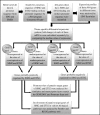Potential contribution of SIM2 and ETS2 functional polymorphisms in Down syndrome associated malignancies
- PMID: 23343470
- PMCID: PMC3563522
- DOI: 10.1186/1471-2350-14-12
Potential contribution of SIM2 and ETS2 functional polymorphisms in Down syndrome associated malignancies
Abstract
Background: Proper expression and functioning of transcription factors (TFs) are essential for regulation of different traits and thus could be crucial for the development of complex diseases. Subjects with Down syndrome (DS) have a higher incidence of acute lymphoblastic leukemia (ALL) while solid tumors, like breast cancer (BC) and oral cancer (OC), show rare incidences. Triplication of the human chromosome 21 in DS is associated with altered genetic dosage of different TFs. V-ets erythroblastosis virus E26 oncogene homolog 2 (ETS2) and Single Minded 2 (SIM2) are two such TFs that regulate several downstream genes involved in developmental and neurological pathways. Here we studied functional genetic polymorphisms (fSNP) in ETS2 and SIM2 encoding genes in a group of patients and control subjects to better understand association of these variants with DS phenotypes.
Methods: We employed an in silico approach to identify potential target pathways of ETS2 and SIM2. fSNPs in genes encoding for these two TFs were identified using available databases. Selected sites were genotyped in individuals with DS, their parents, ALL, BC, OC as well as ethnically matched control individuals. We further analyzed these data by population-based statistical methods.
Results: Allelic/genotypic association analysis showed significant (P < 0.03) differences of rs2070530, rs1051476, rs11254, rs711 for DS subjects compared to control. rs711 also exhibited significantly different genotypic distribution pattern in parents of DS probands (P < 0.02) and BC patients (P < 0.02). Interaction analysis revealed independent main effect of rs711 in all the groups, while rs11254 exhibited independent main effect in DS subjects only. High entropy values were noticed for rs461155 in the solid tumor groups. Significant interactive effects of rs2070531 with rs1051475, rs1051476, rs11254 were observed in all the groups except DS.
Conclusions: We infer from the present investigation that the difference in frequencies of fSNPs and their independent as well as interactive effects may be the cause for altered expression of SIM2 and ETS2 in DS and malignant groups, which affects different downstream biological pathways. Thus, altered expression of SIM2 and ETS2 could be one of the reasons for variable occurrence of different malignant conditions in DS.
Figures


Similar articles
-
Exploratory investigation on functional significance of ETS2 and SIM2 genes in Down syndrome.Dis Markers. 2011;31(5):247-57. doi: 10.3233/DMA-2011-0825. Dis Markers. 2011. PMID: 22048266 Free PMC article.
-
Differential allelic distribution of V-ets erythroblastosis virus E26 oncogene homolog2 (ETS2) functional polymorphisms in different group of patients.Gene Expr. 2010;15(2):61-73. doi: 10.3727/105221611x12973615737541. Gene Expr. 2010. PMID: 21526717 Free PMC article.
-
ETS family of genes in leukemia and Down syndrome.Am J Med Genet Suppl. 1990;7:251-61. doi: 10.1002/ajmg.1320370751. Am J Med Genet Suppl. 1990. PMID: 2149958 Review.
-
The role of the proto-oncogene ETS2 in acute megakaryocytic leukemia biology and therapy.Leukemia. 2008 Mar;22(3):521-9. doi: 10.1038/sj.leu.2405066. Epub 2007 Dec 20. Leukemia. 2008. PMID: 18094719 Free PMC article.
-
Down syndrome and malignancies: a unique clinical relationship: a paper from the 2008 william beaumont hospital symposium on molecular pathology.J Mol Diagn. 2009 Sep;11(5):371-80. doi: 10.2353/jmoldx.2009.080132. J Mol Diagn. 2009. PMID: 19710397 Free PMC article. Review.
Cited by
-
Ten Reasons Why People With Down Syndrome are Protected From the Development of Most Solid Tumors -A Review.Front Genet. 2021 Nov 5;12:749480. doi: 10.3389/fgene.2021.749480. eCollection 2021. Front Genet. 2021. PMID: 34804119 Free PMC article. Review.
-
SIM2, associated with clinicopathologic features, promotes the malignant biological behaviors of endometrial carcinoma cells.BMC Cancer. 2025 Apr 11;25(1):666. doi: 10.1186/s12885-025-14077-0. BMC Cancer. 2025. PMID: 40217155 Free PMC article.
-
Involvement of the Endocrine-Disrupting Chemical Bisphenol A (BPA) in Human Placentation.J Clin Med. 2020 Feb 3;9(2):405. doi: 10.3390/jcm9020405. J Clin Med. 2020. PMID: 32028606 Free PMC article.
-
Synthetic combinations of missense polymorphic genetic changes underlying Down syndrome susceptibility.Cell Mol Life Sci. 2016 Nov;73(21):4001-17. doi: 10.1007/s00018-016-2276-0. Epub 2016 May 31. Cell Mol Life Sci. 2016. PMID: 27245382 Free PMC article. Review.
-
Cortical Folding of the Primate Brain: An Interdisciplinary Examination of the Genetic Architecture, Modularity, and Evolvability of a Significant Neurological Trait in Pedigreed Baboons (Genus Papio).Genetics. 2015 Jun;200(2):651-65. doi: 10.1534/genetics.114.173443. Epub 2015 Apr 14. Genetics. 2015. PMID: 25873632 Free PMC article.
References
-
- Michaud J, Fan CM. Single-minded-two genes, three chromosomes. Genome Res. 1997;7:569–571. - PubMed
-
- Wharton KA Jr, Franks RG, Kasai Y, Crews ST. Control of CNS midline transcription by asymmetric E-box-like elements: similarity to xenobiotic responsive regulation. Development. 1994;120:3563–3569. - PubMed
Publication types
MeSH terms
Substances
LinkOut - more resources
Full Text Sources
Other Literature Sources
Medical

